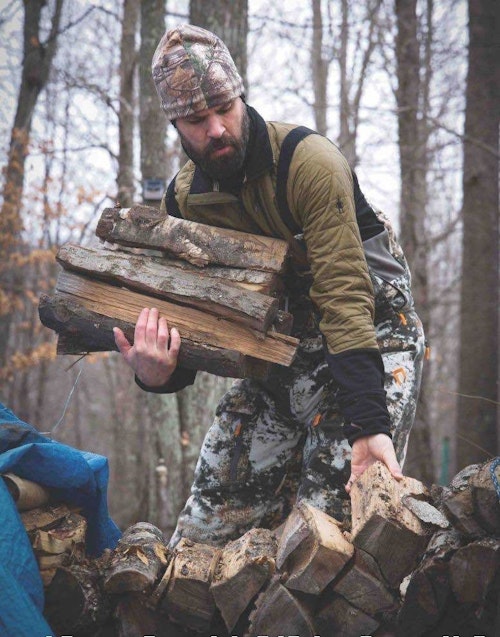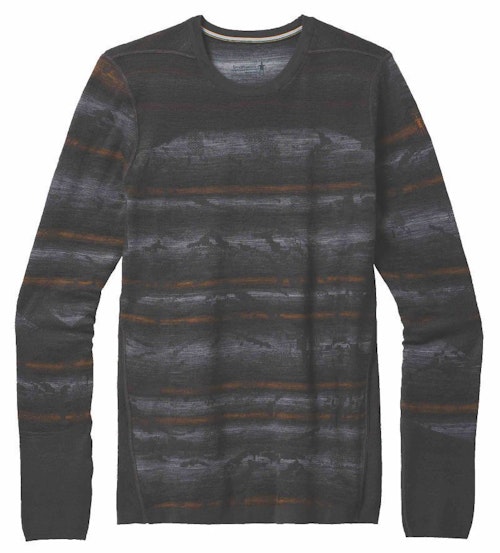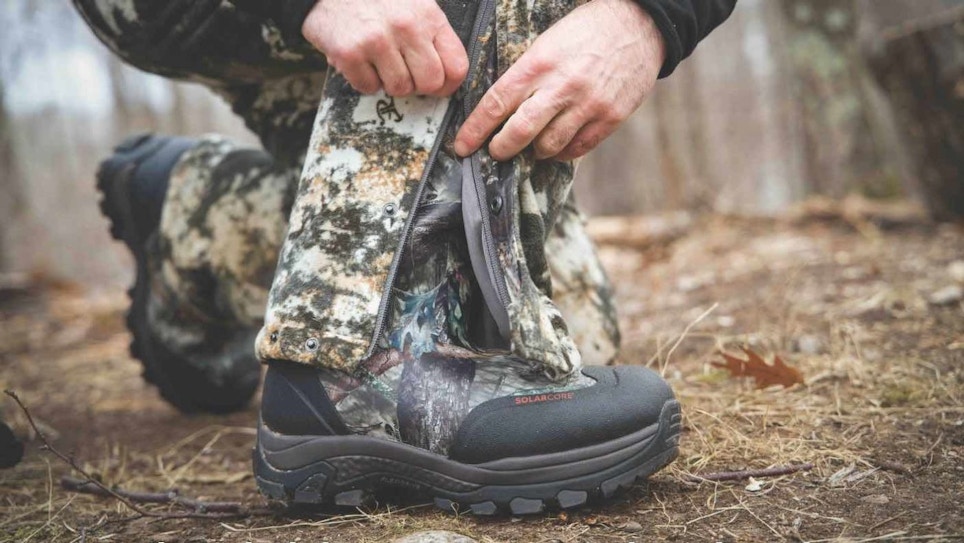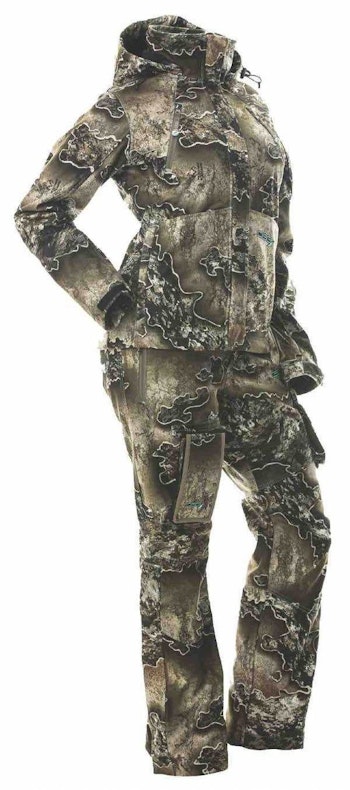Legends are made in the late season, when the last die-hard hunters cling to frozen treestands hoping to outlast the ghost buck that’s finally let his guard down a little to feed in the daylight.
The cold winds of November and December don’t make it easy, but you can help. A carefully curated selection of cold-weather gear can give your customers the protection they need to last through the worst weather conditions.
I hunt primarily in northern Wisconsin, and I spend a lot of time in the woods from October through December. Without good gear, it’s impossible to stay comfortable afield. And forget about an all-day sit in late November if you’re not fully equipped for the cold.
There’s plenty of apparel aimed at keeping the elements at bay, but you can’t stock it all. The challenge is making sure the items you do stock are effective and versatile, and that takes knowledge beyond the manufacturer’s product description.
You can’t fully test all the gear you sell, but you might gain some insight from my time afield in a variety of jackets, bibs, base layers and other gear. There are some clear takeaways.
Bibs
I’ve never been a huge fan of bibs, but the Scentlok BE:1 Fortress and Nomad Conifer bibs have swayed my opinion.
I knew the BE:1 Fortress bibs were warm the second I put them on. It felt like I was stepping into a sleeping bag. Thermal-mapped Thinsulate and 100% waterproof construction made me feel completely protected from the cold.
They also feature fleece-lined handwarmer pockets, zippered back pockets, and cargo pockets on the thighs with a snap closure and zippered side access. An elastic panel across the back gives these bibs more of a fitted feel around the waist. And they’re extremely quiet.
I first wore them with heavy, grid-pattern long underwear. It was a warm combo to be sure, but the bibs are somewhat modestly cut and tended to bind a little against the heavy base layer. I later switched to a lighter base with a smoother exterior finish and was far more comfortable — both walking and sitting — and still stayed plenty warm.
The tops of these bibs are also somewhat modestly cut, but I didn’t find that limiting. I appreciated the fact they didn’t feel bulky under my jacket. On the coldest days I wore a heavy base layer and Smartwool hybrid half-zip under the straps and was perfectly comfortable without feeling like the bundled-up kid in “A Christmas Story.”
The Nomad bibs were a contrast to the ScentLoks in some ways. They’re both light, quiet and warm and both zip to the knee, but the Nomads have a slightly looser feel. They were a little roomier and more accommodating of layers for longer sits, but they didn’t feel overly baggy over lighter layers or when I was on the move.
The Nomads were more versatile in that regard. They’re also a little thinner and lighter weight, with a bit more stretch. And while they might not be as warm as the Fortress bibs on their own, they were completely comfortable over my heaviest base layer.
Like the Fortress bibs, the Nomads have fleece-lined handwarmer pockets and cargo pockets on the thighs with a snap closure and zippered side access. But they don’t have back pockets or elastic around the waist.
Both of these bibs have earned space in my gear locker, and they’re deserving of space on your racks.

Jackets
While the Nomad and ScentLok bibs in this test overlap considerably in coverage, the jackets served distinctly separate roles in my hunting.
The ScentLok BE:1 Fortress parka immediately replaced a heavy, insulated wool parka I’ve worn the past few years in the coldest weather. The Fortress weighs considerably less — a huge advantage — and while it’s not quite as heavily insulated, it stopped the wind better and kept me warmer overall. It’s also more comfortable and much easier to move in.
The Fortress pretty much covered all the bases for me: It was quiet, it kept me warm and dry, and it had plenty of pockets without being overly bulky, as well as a functional and comfortable hood. Plus it has ScentLok’s Carbon Alloy scent-control technology. The harness slot in the upper back is also an excellent feature.
My only knock on the Fortress parka is pretty minor, and maybe just personal taste, but I prefer an adjustable snap or hook-and-loop cuff over an elastic closure on heavier jackets. Worth noting, however, is that this parka is part of a system and the cuffs fit perfectly inside the cuffs of the BE:1 gloves.
The Nomad Harvester jacket is in a different category altogether. It’s warmer than its weight, but it’s not made for long hours on stand in truly cold weather.
The company classifies this jacket as a mid-weight, mid-season jacket, but with the right layers, you could wear it for a few hours on stand on a snowy December day. On colder days, however, it’s better suited to a more mobile hunting style. It actually excelled in that regard. And if your winter weather isn’t quite as severe as northern Wisconsin’s, this might be all the jacket your customers need.
The Harvester was built to be light and comfortable, not to carry a day’s worth of gear. Pockets are refined to two Sherpa-lined front zips and a zippered phone pocket on the chest. One day I wore a Tenzing pack over it, which was a nice combo for covering ground with all the essentials on a cold November day.
The shell material (polyester) has a soft, quiet finish and a nice stretch-factor that was accommodating every time I had to crawl over or under something. I also really liked the high pile on the jacket’s liner and collar. It was comfortable in every aspect.
The Nomad jacket is a great combination of light yet warm, bulk-free while still accommodating warmer layers, and SilverZ scent control adds to its whitetail readiness.

Nice Surprise
The surprise of this whole test was how strong Smartwool came to the table. I’ve enjoyed many pairs of Smartwool socks over the years, but I wasn’t too familiar with the company’s other offerings.
The SmartLoft 60 Hybrid Half Zip is built on a polyester body with a merino wool lining and recycled wool insulation beneath the nylon upper shell. It has thumb loops on the cuffs, but it slipped easily into every jacket I wore it under without using the loops.
On the coldest days, I wore a heavy cold-weather base layer under it and the Fortress parka over the top. It was also great with a lighter long underwear top and the Nomad jacket on less frigid days. On some 40-plus-degree days it was my top layer while working around the cabin.
This is my new favorite mid layer, no question. It’s really an excellent combination of warmth, weight and fit, and it elicited more comments than any of the other gear I tested.
Worth noting, while I didn’t have a chance to test them, the Smartwool Smartloft-X 60 pants look like they’d be an ideal layer under a pair of Nomad Conifer bibs when it gets legitimately cold.
Happy Feet
There’s a lot of swamp in my hunting country, so I spend a lot of time in rubber boots. And Thorogood is my new standard.
The Thorogood Infinity FD rubber boots hold 1,600 grams of Thinsulate and feature a Solarcore lining in the toecap and foot bed. Solarcore is an aerogel lining that Thorogood says has been tested to retain 50% more heat. I can’t verify percentages, but I can tell you these boots are warm.
The foot bed is comfortable, and a composite shank provides the right amount of stiffness in the sole. The ankle opening is big enough that pulling the boots off isn’t a struggle, but not so open that they feel boxy or sloppy.
On the coldest days, I wore these boots with a pair of Darn Tough over-the-calf Hunter socks, and my feet were as warm as they’ve ever been in rubber boots. I should note that while my standard size was comfortable with very light socks, I had to size up to comfortably wear thicker socks.
These boots are on the heavy side and wouldn’t be my choice for covering a lot of ground, but that’s not really the point of a boot like this. I stayed dry in the swamp and warm on stand. That’s the point.
The Rocky Mountain Stalker boots filled a different role for me. They’re warm and waterproof in their own right, but they’re not a slosh-through-the-swamp kind of boot. I was immediately surprised by how light these boots are. I tried them on with a pair of thinner wool-blend socks and initially thought I might need a half size larger, but once I did a little walking in them, I was impressed with the fit and comfort. And I was able to wear thicker socks once they loosened up a little.
They have a moderately stiff sole thanks to a fiberglass shank with a lightweight EVA midsole. Uppers are made of full-grain leather and 1,200-denier nylon. They are fully waterproof, with 1,000 grams of Thinsulate Ultra insulation. The lace-locking system is another nice feature. I always have to double-knot my other boots, but the Mountain Stalkers stayed tight with a single knot every time.
I figured this would be a good pair of boots, but I was surprised by how much I liked them. They’re not ideal for swamp work, but they got it done pretty much everywhere else. If 35 degrees is cold in your area, these are all the boots your customers will need. If not, Rocky also makes a 1,400-gram version of the Mountain Stalker.

Socks
I’m kind of a sock guy. I get cold feet but I don’t like to come in, so I’m always looking for better socks. Smartwool, Under Armour, Carhartt, Wigwam — I own plenty. And Darn Tough stacks up.
The company sent me four pairs, Paul Bunyan over-the-calf and three versions of the Hunter socks: over-the-calf, boot and micro crew.
When Darn Tough says these socks are fully cushioned, they’re not overselling. They felt more like a piece of gear than just a sock. In the way that a really good mid layer feels like it can be worn as a shirt or a jacket equally well, the Darn Tough socks have more of a built-for-weather feel in combination with a soft interior and comfortable fit. And they perform.
The heaviest socks Darn Tough sent, the over-the-calf Hunters, didn’t fit comfortably in the Rocky boots, but pairing them with the Thorogoods provided an extremely warm and comfortable combination. The Paul Bunyans quickly became my sock of choice in the Mountain Stalkers. I wore them obsessively all winter long.
The micro crew and boot versions of the Hunters were nice, too, but in cold weather, I’m partial to over-the-calf socks. They just stay up better.
Gloves
Much like feet, cold hands can ruin an outing, but they’re a little easier to deal with.
The ScentLok BE:1 Fortress gloves are part of the complete BE:1 Fortress system and fit nicely with the Fortress Parka. They were comfortable and performed well on several hunts, even for someone who always gets cold hands. They allow a decent amount of finger dexterity in a fairly substantial glove. They’re windproof and waterproof, with 60 grams of Thinsulate and a leather palm for good grip. And of course they feature ScentLok’s Carbon Alloy scent control technology.
Nomad supplied my other pair of test gloves. The Harvester gloves are considerably lighter than the Fortress gloves, with a slightly stretchy feel and soft high-pile interior that’s warm and comfortable.
These gloves aren’t made for long hours in the cold, but I really liked them when I was walking. I was comfortable handling a gun and even a crossbow while wearing them. And they’re touchscreen-compatible, which made pulling up the weather report or my OnX app a breeze.
Back to Base
Good base layers are key for the cold-weather hunter. Smartwool provides some good options.
I tested the IntraKnit 200 Pattern crew and bottom. Both pieces feature body-mapped mesh ventilation knit seamlessly into a quick-drying merino/polyester blend, with extra flex in the elbows and knees. The result is a slim-fitting, custom sort of feel, minus the compression factor that can make some garments uncomfortable.
These base layers are made for active cold-weather pursuits. They’re warm enough to wear under your bibs or whatever you wear on stand — I liked them under the Nomad bibs — but they’re made to move. The lack of bulk, combined with the flex zones and ventilation, make them ideal for hunting on foot without having to worry about getting sweaty and then freezing.
I would have preferred a more fitted cuff on the sleeves, and the waistband on the bottoms seemed heavier than necessary, but I really liked both pieces. They’re versatile and comfortable, and I kept wearing them all winter.

Another Surprise
I mentioned that the Smartwool SmartLoft 60 Hybrid Half Zip was my surprise of the lot, but the Smartwool balaclava also stood out.
On cold days, I like having something around my neck and something thin under my hat, but I have never worn a proper balaclava that I found comfortable. They’re always too tight around my neck or too bulky to be comfortable in my jacket. The Smartwool tackles both issues, and it fits comfortably under a hat. It’s also warm. This will be part of my regular deer hunting attire until it’s lost or destroyed. And then I’ll buy another.
Share the Knowledge
Fit, function, features and capabilities — these are the kinds of things I try to suss out when I’m in a store looking at gear. I want a good feel for how I can use it. This is where a knowledgeable staff member can be a huge asset.
If all you can tell me is where your bibs are or what customers seem to like, you’re not helping me. And if you’re not helping me, I find it much easier to go somewhere else or just order online. Being able to provide knowledge of specific items and the opportunity to try on those items in your store gives you a huge advantage over online retailers.
None of these products are the only solution, but I’d say they’re all good options. While there’s plenty of other gear you could and should consider stocking, you can be sure customers will appreciate the varied features and capabilities of the items covered here.
Quality and versatility go a long way in moving product out the door, and that’s a good start.
Sidebar: What About Women’s Wear?
Although the numbers of female hunters continue to grow, there’s no denying that women still make up a small percentage of the shoppers who come through your store. Still, many stores don’t carry any women’s camo at all, so having a small selection could make you the go-to shop in your area.
Many brands make women’s camo these days, with a few specifically dedicated to selling only women’s hunting and outdoor apparel. One of the newer women-only brands on the market is DSG Outerwear, and they’ve already made a splash thanks to one simple concept: Sizing.
DSG stands for Doing Something Good, and it was founded by Wendy Gavinski after years of her personal frustration trying to find women’s outerwear for active outdoor lifestyles. The company produces a wide range of clothing options for hunting, fishing, ice fishing and snowmobiling, using quality materials and components. Perhaps best of all, DSG clothing is built to perform, designed by women to fit women of all shapes and sizes. They carry sizes from XXS up to 5XL, which is absolutely unheard of but much needed in the women’s camo space.
There are plenty of options in DSG’s hunting lineup for all seasons, including a drop-seat bib that your female shoppers will appreciate when it’s time to answer nature’s call. Multiple camo patterns are available, and a couple of blaze orange and blaze pink options round out the line. You might not have a lot of floor space available to stock women’s camo, but if you can spare a few racks, consider stocking a few seasonally-appropriate options in a variety of sizes, and let shoppers know that additional sizes and camo patterns can be ordered. Dedicating a small amount of space to your female customers can pay big dividends, especially if your competitors aren’t meeting shoppers’ needs.







